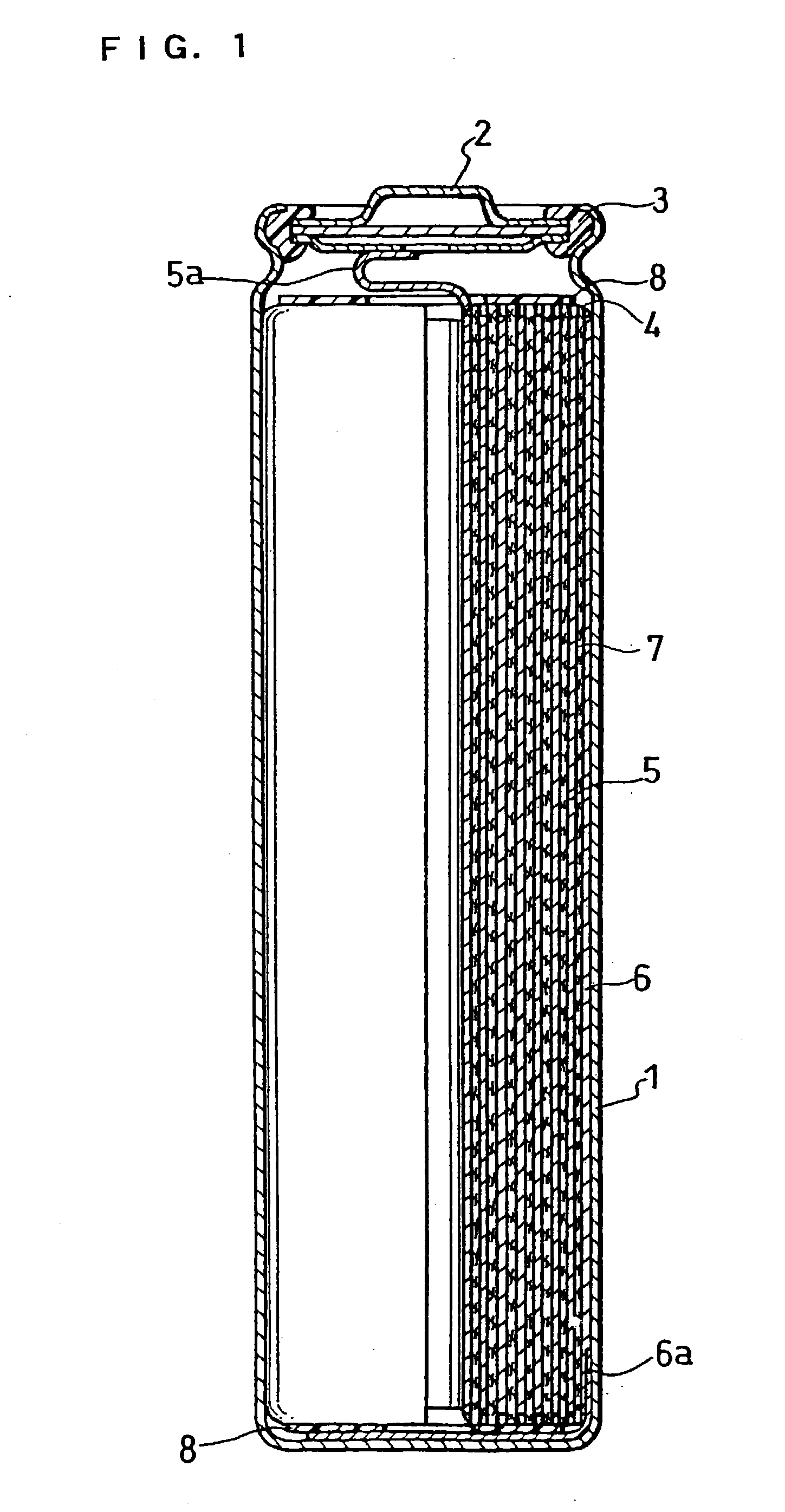Nonaqueous electrolytic secondary battery
a secondary battery, non-aqueous electrolyte technology, applied in the maintenance/servicing of primary cells, batteries, non-aqueous electrolyte cells, etc., can solve the problems of excessive heat generation, difficult cutting costs, and troublesome structure of providing them inside the small and thin battery, so as to reduce the efficiency of lithium ions extraction and reduce the thermal stability of the positive electrode active material , the effect of increasing the internal resistan
- Summary
- Abstract
- Description
- Claims
- Application Information
AI Technical Summary
Benefits of technology
Problems solved by technology
Method used
Image
Examples
example 2
[0075] Cylindrical batteries were constructed as in Example 1 except that 3-chlorothiophene, furan, o-terphenyl, m-terphenyl, p-terphenyl, diphenyl ether, 2,3-benzofuran, bis(p-tolyl)ether, diallyl ether, allyl butyl ether, 3-phenoxy toluene or cyclohexyl benzene was used as the additive. They were named as Batteries 2 to 13. C / A value of Batteries 2 to 13 was also 3.54 mAh / cm.sup.2, which was the same as that of Battery 1.
example 3
[0076] (i) Both sides of 10 .mu.m thick aluminum foil serving as the positive electrode current collector were directly coated with the same positive electrode material mixture as that in Example 1, dried and rolled with pressure to give a positive electrode having a thickness of 0.16 mm, a width of 55 mm and a length of 540 mm. Accordingly, this electrode does not have a resistance layer.
[0077] (ii) Nickel powder serving as the conductive particulate material and polyethylene serving as the binder polymer and having a softening temperature of 120.degree. C. were mixed in a weight ratio of 10:1, and a proper amount of carboxymethyl cellulose was added thereto as the thickener to give a paste like mixture.
[0078] Both sides of 10 .mu.m thick copper foil serving as the negative electrode current collector were coated with the aforementioned mixture to a thickness of 5 .mu.m or less, and dried to provide a resistance layer.
[0079] Both sides of the negative electrode current collector ha...
example 4
[0082] The length of the positive electrode current collector having the resistance layer and the amount of the positive electrode material mixture to be applied thereon were adjusted to obtain a positive electrode having a thickness of 0.0183 mm, a width of 55 mm and a length of 2800 mm. Likewise, the length of the negative electrode current collector and the amount of the negative electrode material mixture to be applied thereon were adjusted to obtain a negative electrode having a thickness of 0.017 mm, a width of 56 mm and a length of 2845 mm. Battery 15 was constructed as in Example 1 except that the above-mentioned positive and negative electrodes and a polyethylene separator having a thickness of 0.018 mm, a width of 58 mm and a length of 5950 mm were used. Battery 15 had a capacity C of 632 mAh, and a ratio of battery capacity C to facing area A of the positive and negative electrodes: C / A was 0.205 mAh / cm.sup.2.
PUM
 Login to View More
Login to View More Abstract
Description
Claims
Application Information
 Login to View More
Login to View More - R&D
- Intellectual Property
- Life Sciences
- Materials
- Tech Scout
- Unparalleled Data Quality
- Higher Quality Content
- 60% Fewer Hallucinations
Browse by: Latest US Patents, China's latest patents, Technical Efficacy Thesaurus, Application Domain, Technology Topic, Popular Technical Reports.
© 2025 PatSnap. All rights reserved.Legal|Privacy policy|Modern Slavery Act Transparency Statement|Sitemap|About US| Contact US: help@patsnap.com


